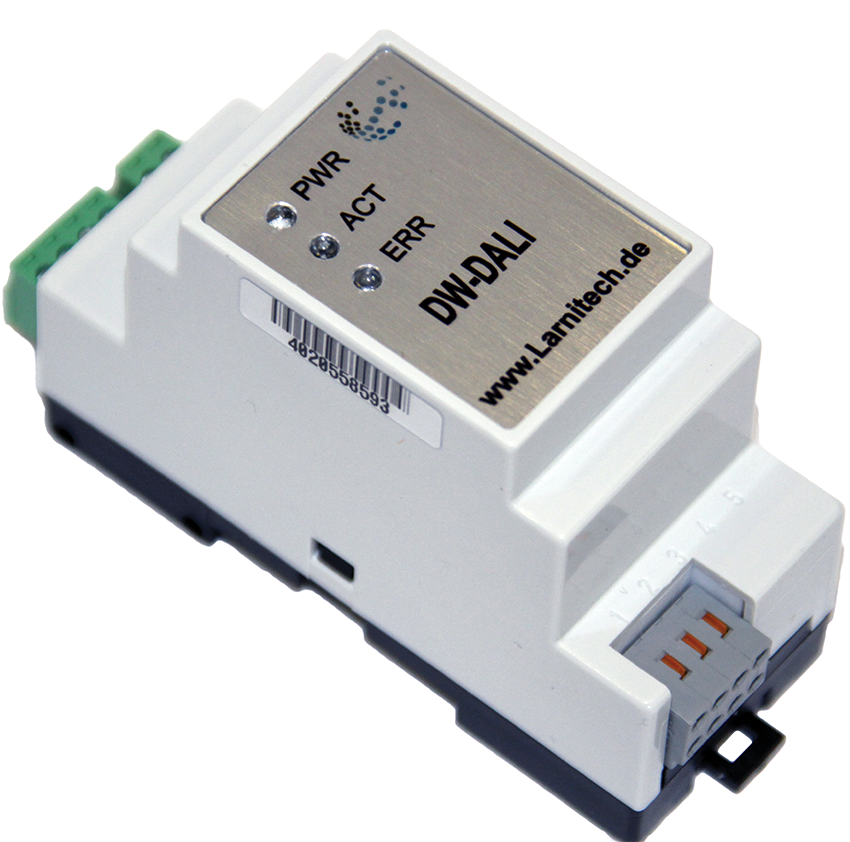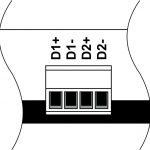Difference between revisions of "DW-DALI.A"
(Marked this version for translation) |
m (Add Revision changer) |
||
| Line 2: | Line 2: | ||
<translate> | <translate> | ||
<!--T:1--> | <!--T:1--> | ||
| + | {{RevisionChanger | hasA = 1 | hasC = 1}} | ||
{{Infobox module | {{Infobox module | ||
| name = DW-DALI.A | | name = DW-DALI.A | ||
Latest revision as of 11:09, 25 March 2024
| DW-DALI.A | |||||||
|---|---|---|---|---|---|---|---|
 | |||||||
| |||||||
| |||||||
Introduction
DW-DALI.A Module Installation Manual describes the procedure for its installation, assembly, operation and setting. While working with the module, you must strictly comply with all the requirements set out in this manual. Failure to comply may result in damage to the device, its failure, electric shock, fire and other fallout.
CAUTION! All work related to the installation, connection, setting up, service and support must be carried out by qualified personnel with sufficient skills and experience in working with electrical equipment. To avoid the risk of fire, electric shock, damage to the system and/or personal injury, the system installation and assembly must be performed in accordance with the instructions listed below:
- all connectivity work must be carried out with the power turned OFF;
- use appropriate tools and personal protection against electric shock;
- do not use damaged cables, wires and connectors;
- avoid folding the cables and wires;
- do not apply excessive force to the wires by kinking or pressing them too hard: the inner conductors of the cables and wires may get stripped or damaged;
- do not use the power socket with poor contacts to connect;
- do not exceed the load limit parameters specified in the manual;
- the supply conductors wire section is subject to the specifications for current density limit, insulation type and wire material. Light section can result in cable overheating and fire.
When the power is on, NEVER:
- connect/disconnect the connectors;
- open modules and sensors.
Module dimensions

Internal layout

Module configuration and correct use
Module correct use
DW-DALI.A module is to be used as a part of a wired system Larnitech Smart House. DW-DALI.A is to be used for data exchange between devices connected to the CAN bus, and devices such as electronic ballasts and dimmers, supporting DALI (Digital Addressable Lighting Interface) interface.
Scope of supply
The scope of supply is as follows:
| Parameter name | Value |
|---|---|
| DALI ports qty | 2 |
| DALI-line voltage supply | 23.5 – 24.5 V DC |
| Peak current of DALI-line power supply | 1A |
| Peak current in DALI-line | 300 mА |
| Maximum DALI devices quantity | 641 |
| Power supply | 11.5 … 27.5 V DC from CAN |
| Max current(24V) | 30 mA |
| Bus type | CAN (4-wire) |
| Equipment installation type | DIN rail (EN 60715) |
| Case material | ABS |
| Protection | IP40 |
| Temperature range | -10 … +50 °C |
| Size | 2U, 35x97x58 mm |
| Weight | 75g |
Module general structure

At the bottom of the casing there is a connecting plug (3) to the CAN-bus of Smart House network.
The physical configuration and contact point assignment of each connector are shown in table
| Connector | Contact | Assignment |
|---|---|---|
1 DALI |
D1+ D1- D2+ D2- |
DALI1 bus DALI2 bus |
2 DALI power supply |
+24V GND |
+24V — DALI bus power supply GND — common |
| 3 Module indicating unit |
The scenario for module indicating unit is shown below | |
4 CAN |
VCC GND L H |
VСС — +24V power supply of CAN-bus GND — common L — CAN-L data bus H — CAN-H data bus |
| Indicator | Status | Description |
|---|---|---|
| Power | Power | |
| Power not available | ||
| Activity | Data communication | |
| Data communication not available | ||
| Error | No errors | |
| Overheating | ||
| The data has not been transferred via the CAN bus for at least 5 minutes. | ||
| No power on the DALI bus or over current (more then 180 mA) on DALI bus. If over current is at both bus blinking twice in half a second. |
Module installation and assembly
Before connecting the module, you must determine the module installation place. Note: The module must be installed near 24V power supply.
Typical diagram for DW-DALI.A module connection

Module installation and connection procedure
CAUTION! You must precisely follow the recommendations listed in the «Safety Requirements» section of this manual.
- Install the module in the switchboard on the DIN-rail and secure it with special latches available on the module base.
- Connect the CAN-bus (4).
- Connect the DALI-bus (1).
- Connect the DALI power connector (2).
- Energise the module power supply (24 V).
Module shutoff and disassembly procedure
- isconnect the power connector (2).
- Disconnect the DALI connector (1).
- Disconnect the connector of CAN-bus (4).
- Demount the module from the DIN-rail, releasing the latch, available at the module base.
Hardware setup
To configure and control DW-DALI module, you must install Larnitech software on your smartphone or t, which is available in App Store and Play Market. After installation, follow the System Setup Instructions.
Fault diagnostics and handling
The following are some possible faults and ways of fault handling. If you have any difficulty, or face the fault undeclared here, please contact the Technical Support: http://www.larnitech.com/support/ or support@larnitech.com. There are also some tips in the FAQ section at our website http://www.larnitech.com/faq/
System Setup Instruction
Each DALI bus can use 40 DALI devices. Together DALI buses for one DW-DALI.A can use 64 DALI devices. Address DALI device must be from 1 to 63. To add DALI devices to DALI bus, add «hw» to tag with SubID 98, hw=”bus1=’1,2,3,…’ bus2=’1,2,3,…’ “:
- bus1 — first DALI bus data;
- bus2 — second DALI bus data;
- 1,2,3 — address DALI devices.
Configuring DALI device settings(set from scripts):
— setStatus(ID:SID, {0xC0, ADDR}) – set address DALI devices, need to connect one DALI device on DALI bus data:
- ID:SID — address DALI bus data (com-port in logic.xml);
- 0xC0 — command for set address DALI devices;
- ADDR — address DALI device.
— setStatus(ID:SID, {0xD4, ADDR, LEVEL}) — set default brightness:
- ID:SID — address DALI bus data (com-port in logic.xml);
- 0xD4 — command for set default brightness DALI devices;
- ADDR — address DALI device;
- LEVEL — brightness level, 0…250.
— setStatus(ID:SID, {0xD3, ADDR, TIME}) — set the brightness change time:
- ID:SID — address DALI bus data (com-port in logic.xml);
- 0xD3 — command for set the brightness change time DALI devices;
- ADDR — address DALI device;
- TIME — brightness change time, in seconds.
— setStatus(ID:SID, {0xD1, ADDR, LEVEL}) — set minimum brightness:
- ID:SID — address DALI bus data (com-port in logic.xml);
- 0xD1 — command for set minimal brightness DALI devices;
- ADDR — address DALI device;
- LEVEL — brightness level, 0…250.
— setStatus(ID:SID, {0xD0, ADDR, LEVEL}) — set maximum brightness:
- ID:SID — address DALI bus data (com-port in logic.xml);
- 0xD0 — command for set maximum brightness DALI devices;
- ADDR — address DALI device;
- LEVEL — brightness level, 0…250.
HW Settings
| Name | Type, range | SUBID | Default | Description |
|---|---|---|---|---|
| bus1 | string | 98 | — |
Example: 1hw="bus1='1-30'" — create in logic 30 dimmer l
2hw="bus1='1L-30'" — create in logic 30 l
3hw="bus1='1L-10,20-35'" — create in logic 10 lamp and 15 dimmer l
4hw="bus1='6,35,2,1,54'" — create in logic 5 dimmer l
|
| bus2 | string | 98 | — |
Example: 1hw="bus2='1-30'" — create in logic 30 dimmer l
2hw="bus2='1L-30'" — create in logic 30 l
3hw="bus2='1L-10,20-35'" — create in logic 10 lamp and 15 dimmer l
4hw="bus2='6,35,2,1,54'" — create in logic 5 dimmer l
|
| def | string 'ON' | certain SubID | 'OFF' | def is the element status is set after restart
1hw="def='ON'"
|
| min | integer (0…100) | certain SubID | 0 | minimum dimming level, 0..100;
Example: 1hw="min=30"
|
| max | integer (0…100) | certain SubID | 100 | maximum dimming level, 0..100;
Example: 1hw="max=80"
|
| [hill] | string | certain SubID | — | abrupt change at the beginning, gradual change at the end
Example: 1hw="min=30 max=80 hill"
|
| [pit] | string | certain SubID | — | gradual change at the beginning, abrupt change at the end
Example: 1hw="min=30 max=80 pit"
|
1<item addr="450:1" auto-period="600" cfgid="80" hw="min=30 max=80 hill" name="Dimmer" type="dimer-lamp" uniq_id="4138"/>
2<item addr="450:2" auto-period="600" cfgid="80" hw="min=30 max=80 pit" name="Dimmer" type="dimer-lamp" uniq_id="4139"/>
3<item addr="450:3" auto-period="600" cfgid="80" name="Dimmer" type="dimer-lamp" uniq_id="4140"/>
4<item addr="450:4" auto-period="600" cfgid="80" name="Dimmer" type="dimer-lamp" uniq_id="4141"/>
5<item addr="450:5" auto-period="600" cfgid="80" name="Dimmer" type="dimer-lamp" uniq_id="4142"/>
6<item addr="450:6" auto-period="600" cfgid="80" name="Lamp" type="lamp" uniq_id="4143"/>
7<item addr="450:7" auto-period="600" cfgid="80" name="Lamp" type="lamp" uniq_id="4144"/>
8<item addr="450:8" auto-period="600" cfgid="80" name="Lamp" type="lamp" uniq_id="4145"/>
9<item addr="450:9" auto-period="600" cfgid="80" name="Lamp" type="lamp" uniq_id="4146"/>
10<item addr="450:10" auto-period="600" cfgid="80" name="Lamp" type="lamp" uniq_id="4147"/>
11<item addr="450:11" auto-period="600" cfgid="80" name="Lamp" type="lamp" uniq_id="4148"/>
12<item addr="450:12" auto-period="600" hw="min=30" cfgid="80" name="Dimmer" type="dimer-lamp" uniq_id="4149"/>
13<item addr="450:13" auto-period="600" cfgid="80" name="Lamp" type="lamp" uniq_id="4164"/>
14<item addr="450:41" auto-period="600" hw="min=30 max=80 hill" cfgid="80" name="Dimmer" type="dimer-lamp" uniq_id="4151"/>
15<item addr="450:42" auto-period="600" hw="min=30 max=80 pit" cfgid="80" name="Dimmer" type="dimer-lamp" uniq_id="4152"/>
16<item addr="450:43" auto-period="600" cfgid="80" name="Dimmer" type="dimer-lamp" uniq_id="4153"/>
17<item addr="450:44" auto-period="600" cfgid="80" name="Dimmer" type="dimer-lamp" uniq_id="4154"/>
18<item addr="450:45" auto-period="600" cfgid="80" name="Dimmer" type="dimer-lamp" uniq_id="4155"/>
19<item addr="450:46" auto-period="600" cfgid="80" name="Lamp" type="lamp" uniq_id="4156"/>
20<item addr="450:47" auto-period="600" cfgid="80" name="Lamp" type="lamp" uniq_id="4157"/>
21<item addr="450:48" auto-period="600" cfgid="80" name="Lamp" type="lamp" uniq_id="4158"/>
22<item addr="450:49" auto-period="600" cfgid="80" name="Lamp" type="lamp" uniq_id="4159"/>
23<item addr="450:50" auto-period="600" cfgid="80" name="Lamp" type="lamp" uniq_id="4160"/>
24<item addr="450:51" auto-period="600" cfgid="80" name="Lamp" type="lamp" uniq_id="4161"/>
25<item addr="450:52" auto-period="600" hw="max=80" cfgid="80" name="Dimmer" type="dimer-lamp" uniq_id="4162"/>
26<item addr="450:53" auto-period="600" cfgid="80" name="Lamp" type="lamp" uniq_id="4165"/>
27<item addr="450:85" cfgid="80" name="RS232" type="com-port" uniq_id="4135"/>
28<item addr="450:86" cfgid="80" name="RS232" type="com-port" uniq_id="4136"/>
29<item addr="450:98" cfgid="80" hw="bus1='1-5,10L-15,20,25L' bus2='1-5,10L-15,20,25L'" name="Temperature" system="yes" type="temperature-sensor" uniq_id="4137"/>